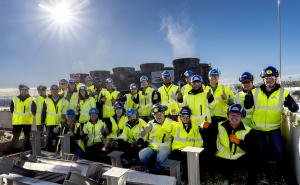Une « fumée » blanche comme signal positif
Comme le panache de fumée blanche annonçant l'élection d'un nouveau pape lorsque les cardinaux se réunissent en conclave, la vapeur qui s'échappe de l'une des cellules de refroidissement est une bonne nouvelle pour le programme ITER. Cette « fumée » blanche (qui est en réalité de la vapeur d'eau) indique que les compresseurs d'hélium situés à l'intérieur de l'usine cryogénique sont en fonctionnement et que la chaleur ainsi générée est évacuée efficacement par l'action combinée du circuit d'eau de refroidissement et du système d'évacuation de chaleur.
Les essais en cours ne concernent qu'une petite partie des 18 compresseurs de plusieurs mégawatts qui alimenteront les « boîtes froides » de l'usine cryogénique. Ces prochaines semaines, d'autres compresseurs seront mis en service, ce qui permettra d'évacuer jusqu'à 25 MW de chaleur.
Le panache de fumée marque une étape importante dans l'aventure menée conjointement par ITER Organization, ITER India et leurs partenaires industriels, qui a débuté en 2016 avec l'examen de conception final du circuit d'eau de refroidissement. Une fois pleinement opérationnel, ce circuit de première importance sera capable d'extraire jusqu'à 1 200 MW de chaleur généré par l'infrastructure industrielle de l'installation et les plasmas expérimentaux.
Entrés en phase d'exploitation courante depuis peu, le circuit d'eau de refroidissement et le système d'évacuation de chaleur sont aujourd'hui prêts à contribuer aux processus d'ITER qui nécessitent un refroidissement par eau continu.
Il s'agit d'une étape importante dont se réjouissent tous ceux qui ont pris part à ce défi. « Nous sommes fiers aujourd'hui de partager le succès de notre projet : la maquette d'ingénierie a donné naissance à une installation opérationnelle », expliquent Pierre Yves Tavennec et Thomas Pralus, les ingénieurs chargés de la mise en service du circuit d'eau de refroidissement d'ITER.
« Tout est maintenant en place pour lancer les essais de réception opérationnelle de l'usine cryogénique, dit David Grillot, le directeur adjoint des systèmes industriels d'ITER. Notre objectif sera de démontrer que le système de réfrigération qui alimente en fluides de refroidissement les clients situés à l'intérieur du tokamak est capable de répondre aux exigences de fonctionnement. »
La production des fluides de refroidissement cryogénique débutera dès l'an prochain afin d'alimenter l'installation d'essai cryogénique des aimants et l'installation d'essai des cryopompes (aux dimensions plus modeste), dont les principaux éléments sont déjà en place dans l'usine cryogénique.


